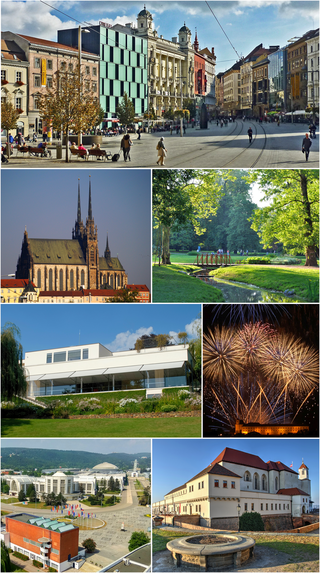
Charles University, or historically as the University of Prague, is the largest and best-ranked university in the Czech Republic. It is one of the oldest universities in the world in continuous operation, the first university north of the Alps and east of Paris. Today, the university consists of 17 faculties located in Prague, Hradec Králové, and Plzeň.

Mendel University in Brno is located in Brno, Czech Republic. It was founded on 24 July 1919 on the basis of the former Tábor Academy. It now consists of five faculties and one institute - the Faculty of AgriSciences, Faculty of Forestry and Wood Technology, Faculty of Business and Economics, Faculty of Horticulture, Faculty of Regional Development and International Studies and Institute of Lifelong Education. It is named since 1994 after Gregor Johann Mendel, the botanist and "father of genetics", who was active in this city during his lifetime.

Brno is a city in the South Moravian Region of the Czech Republic. Located at the confluence of the Svitava and Svratka rivers, Brno has about 400,000 inhabitants, making it the second-largest city in the Czech Republic after the capital, Prague, and one of the 100 largest cities of the European Union. The Brno metropolitan area has approximately 720,000 inhabitants.

Hradec Králové is a city of the Czech Republic. It has about 94,000 inhabitants. It is the capital of the Hradec Králové Region. The historic centre of Hradec Králové is well preserved and is protected by law as an urban monument reservation, the wider centre is protected as an urban monument zone.

Established in 1918, Tallinn University of Technology is the only technical university in Estonia. TalTech, in the capital city of Tallinn, is a university for engineering, business, public administration and maritime affairs. TalTech has colleges in Tartu and Kohtla-Järve. Despite the similar names, Tallinn University and Tallinn University of Technology are separate institutions.

The University of Hradec Králové is a public university in Hradec Králové, Czech Republic, founded on 21 June 2000. It traces its roots back to 1959. The university has about 6,000 students, and the current rector is Jan Kříž.

Masaryk University (MU) is the second largest university in the Czech Republic, a member of the Compostela Group and the Utrecht Network. Founded in 1919 in Brno as the second Czech university, it now consists of ten faculties and 35,115 students. It is named after Tomáš Garrigue Masaryk, the first president of an independent Czechoslovakia as well as the leader of the movement for a second Czech university.

Brno University of Technology is a university located in Brno, Czech Republic. Being founded in 1899 and initially offering a single course in civil engineering, it grew to become a major technical Czech university with over 18,000 students enrolled at 8 faculties and 2 university institutes.

Palacký University Olomouc is the oldest university in Moravia and the second-oldest in the Czech Republic. It was established in 1573 as a public university led by the Jesuit order in Olomouc, which was at that time the capital of Moravia and the seat of the episcopacy. At first it taught only theology, but soon the fields of philosophy, law and medicine were added.
The Indian Defence services have established numerous academies and staff colleges across India for the purpose of training professional soldiers in military sciences, warfare command and strategy, and associated technologies.
Ervín Černý-Křetínský was a physician and Professor of Charles University in Prague.

Czech Technical University in Prague (CTU) is one of the largest universities in the Czech Republic with 8 faculties, and is one of the oldest institutes of technology in Central Europe. It is also the oldest non-military technical university in Europe.

The Czechoslovak People's Army was the armed forces of the Communist Party of Czechoslovakia (KSČ) and the Czechoslovak Socialist Republic from 1954 until 1989. From 1955 it was a member force of the Warsaw Pact. On 14 March 1990 the Army's name was officially reverted to the Czechoslovak Army removing the adjective "People's" from the name. The Czechoslovak Army was split into the Army of the Czech Republic and the Armed Forces of the Slovak Republic after the dissolution of Czechoslovakia on 1 January 1993.

University of South Bohemia in České Budějovice is a public university located in the city of České Budějovice in the Czech Republic. Established in 1991, it has almost 9,000 students in more than 220 programmes including bachelor´s & master´s degrees as well as doctoral programmes and an academic staff 1,500. 592 students are currently enrolled in the university for their doctoral work.

The LudovikaUniversity of Public Service is a higher educational institution in Budapest, Hungary. Established in 2012, it is one of the youngest universities in Central and Eastern Europe; however, its faculties as former independent colleges look back much earlier.

The Government Army was the military force of the Protectorate of Bohemia and Moravia during the German occupation of the Czech lands.
Zoltán Bubeník is the Czech Surgeon General and the chief medical adviser to the North Atlantic Alliance as the 8th Chairman of COMEDS, the committee of Surgeons General of NATO and partner nations.
The 2022–23 season was the 78th in the history of Fotbalový Klub Jablonec and their 29th consecutive season in the Czech First League. In addition to the domestic league, Jablonec participated in this season's editions of the Czech Cup.















